- Home
- Publications et statistiques
- Publications
- Monthly Business Survey – Start of Septe...
The Banque de France publishes a range of monthly and quarterly economic surveys that provide a snapshot of the French economy in the form of business climate indicators and short-term forecasts.
According to the business leaders surveyed (approximately 8,500 companies and establishments questioned between 28 August and 4 September), activity in August picked up in industry and more significantly in market services, partly due to the Paris Olympics, while it fell slightly in construction, due to more days of holiday than in previous years. According to business expectations for September, activity should pick up slightly in industry and services, while little change is expected in construction. Order books are still deemed weak in virtually all industrial sectors (with the notable exception of aeronautics). In the automotive sector, for the past two months, business leaders have reported a decline in the demand for electric vehicles, in favour of a return to ICEs and hybrid vehicles. Our uncertainty indicator based on comments by surveyed companies has changed little in industry and services, and risen slightly in construction.
Selling prices continued to moderate. The share of businesses that increased their prices last month was slightly below pre-Covid August levels in industry and construction, but still slightly above these levels in services.
Recruitment difficulties increased slightly this month: they were cited by 36% of businesses in August, compared with 33% in July. This increase is attributable to market services.
Based on the survey results as well as other indicators, we forecast significant GDP growth in the third quarter of 2024, reflecting underlying growth of around 0.1% to 0.2%, plus the temporary impact of the Paris Olympic and Paralympic Games, which should add another quarter point. This forecast, unchanged from last month, is subject to both upside risks, linked to possible spillover effects from the Olympic Games, and downside risks stemming from the political uncertainty.
1. In August, activity picked up in industry and
more significantly in market services, while it fell
slightly in construction.
In August, activity strengthened in industry at a pace close to that forecast by business leaders last month. While capital goods (weak orders in the automotive sector) and transport equipment (supply chain problems) declined, activity in agri-food and other industrial sectors was up. More specifically, there was sustained growth in wood, paper and printing, chemicals, pharmaceuticals and other industrial products. However, the electrical equipment, automotive, aeronautics and wearing apparel, textiles and footwear sectors witnessed a decline in activity. In the automotive sector, business leaders reported a decline in demand for electric vehicles and a return to ICEs and hybrid vehicles.
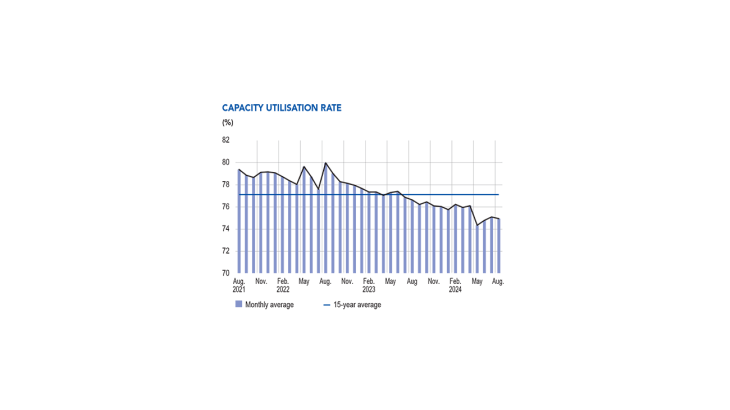
The capacity utilisation rate (CUR) for industry as a whole was virtually stable at 74.9 % (75.1 % in July), close to its 15-year average of 77 %. More specifically, the indicator rose in pharmaceuticals (up 1 percentage point) and in other industrial products (up 2 percentage points). However, this rise was offset by a decline in the aeronautics sector (down 6 percentage points), with business leaders stating that this drop was a one-off, following a buoyant July and positive expectations for September.
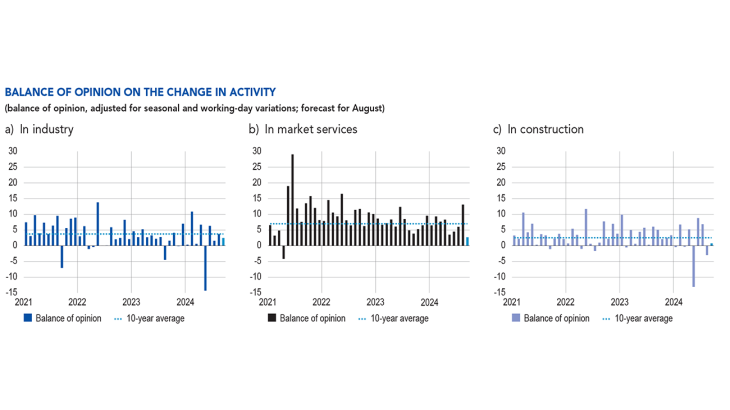
over the past month) stood at 2 points in August in industry. For September (light blue bar), business leaders in industry expect activity to increase by 7 percentage points.
Inventories of finished goods were almost unchanged compared with July. They increased in pharmaceuticals and chemicals, but decreased in the wearing apparel, textiles and footwear, and wood, paper and printing sectors. Levels continue to be deemed high and above their long-term average in most sectors, including the aeronautics, pharmaceutical and automotive industries.
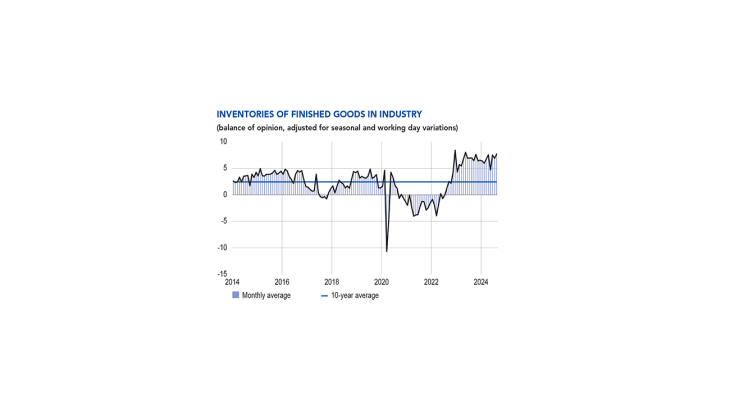
In market services, activity grew significantly in August, at a faster pace than that anticipated by business leaders last month, partly due to the Paris Olympics. This increase was observed in all business services, with the exception of advertising and leasing. Activity also expanded in consumer services, particularly in accommodation and food services, thanks to more clement weather and the 15 August bank holiday. Lastly, the balance of opinion on activity in the temporary employment sector has become slightly positive again. However, it is still being dragged down by the sluggish demand reported in the automotive sector and in construction & public works.
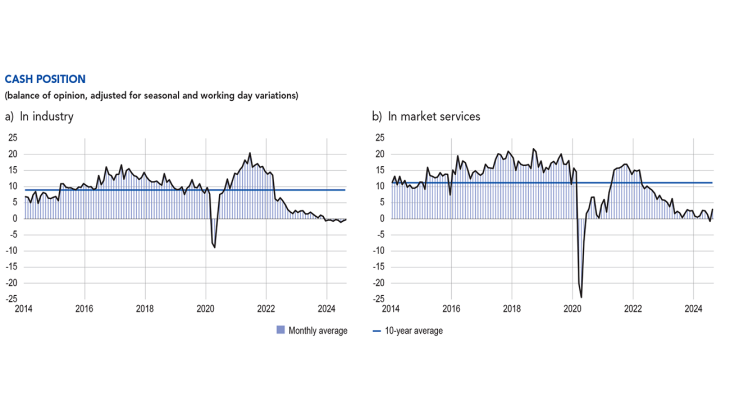
In construction, there was little change in activity in structural works and activity was down in the finishing works sector. Business leaders reported more days of holiday in August than in previous years, in line with worries over the negative effects of the Olympic Games (traffic jams in the Paris region, postponement of construction projects, etc.).
The balance of opinion on cash positions improved slightly in industry. It improved in wearing apparel, textiles and
footwear, agri-food and pharmaceuticals, but deteriorated in the aeronautics and wood, paper and printing sectors.
There was a slight improvement in the balance of opinion on cash positions in market services. It was deemed satisfactory in leisure activities and personal services, publishing, information services and engineering, whereas it was considered low in food services, transport and vehicle repair services.
2. In September, business leaders expect activity to grow slightly in industry and services, and to remain stable in construction
Business leaders in industry expect activity to grow slightly in September, especially in transport equipment (aeronautics) and, to a lesser degree, in agri-food and other industrial sectors (chemicals) and capital goods (computer, electronic and optical products).
In services, activity is also expected to grow, albeit with trends differing across sectors. In business services, publishing, information services, engineering and leasing as well as in accommodation and food services, activity is expected to grow. Conversely, management consultancy is expected to decline slightly.
Lastly, in construction, activity is expected to remain fairly stable in both the structural and finishing works sectors.

There was little change overall in the balance of opinion on industry order books: it improved in metal and metal products manufacturing and in the automotive sector, but declined in computer, electronic and optical products, electrical equipment, chemicals and pharmaceuticals.
In construction, the balance of opinion on order books remained virtually unchanged in August: they remained
very weak in structural works, and were mainly underpinned by energy retrofits in the finishing works sector.
Our monthly uncertainty indicator, which is constructed from a textual analysis of comments by surveyed companies, was- relatively unchanged when compared with July for industry and market services. It rose in the construction sector, particularly in structural works, where business leaders mainly mention the political context as a factor of uncertainty (investment decisions postponed, worries over public procurement contracts).
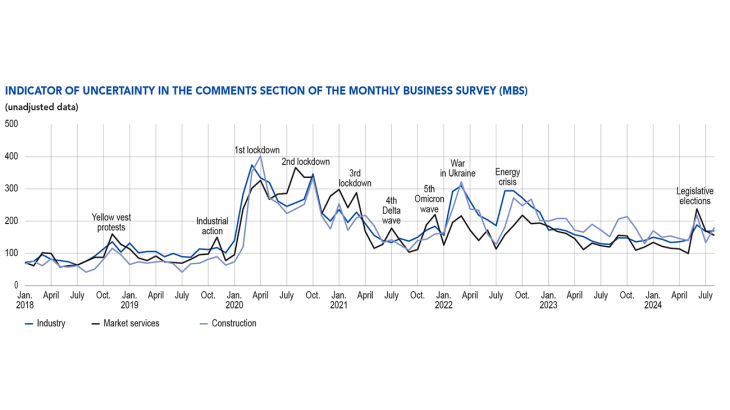
3. Services price dynamics are still continuing to normalise
In August, supply difficulties lessened (9 % of companies mentioned them; down 3 percentage points on July).
Nevertheless, they remained high in the automotive and aeronautics sectors. Supply difficulties in the construction sector remained rare (3 %, as in July).
In industry, business leaders continued to report a slight rise in raw materials prices, and the balance of opinion on finished goods prices1 in August remained positive. More specifically, 4 % of business leaders in industry reported that they had raised their selling prices this month, a proportion close to the levels seen in August during the pre-Covid period, and well below those for the same month in 2021-22. Most of the price rises were in the wood, paper and printing sectors (8 %). Conversely, 3 % of business leaders in industry reported that they had lowered their selling prices in August. Cuts in finished goods prices were reported, especially in machinery and equipment, metal and metal products manufacturing (6 %) and agri-food (7 %).
In construction, 2 % of business leaders reported increasing their quote prices, whereas 5 % reported lowering them, which is a higher proportion than in the month of August in past years.
In services, price dynamics have not yet completely normalised. The proportion of businesses reporting price increases was 6 % (slightly higher than pre-Covid August figures), while the proportion reporting a cut in their prices was 5 %. Price increases in the services sector mainly concerned the accommodation sector (and food services to a lesser degree), cleaning, leisure activities, personal services, and engineering activities.
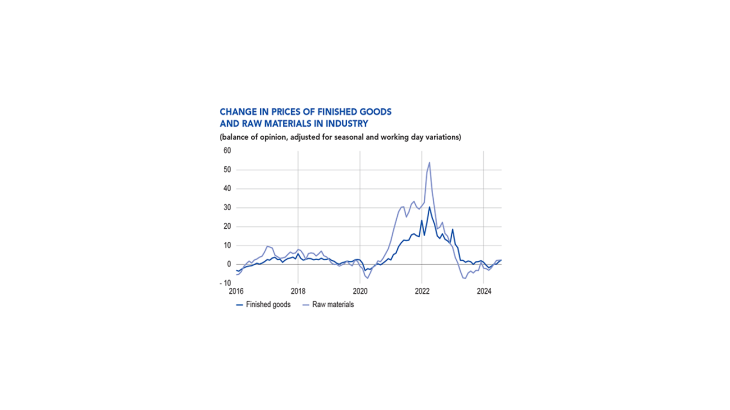
Business leaders’ expectations for September indicate that 9 % of them plan to raise their prices in industry, 7 % in market services and 3 % in construction. In industry, this proportion is relatively higher than in previous months, partly reflecting a seasonal effect in September.

between the share of companies reporting an increase in activity and the share reporting a
fall over the past month) stood at -15 percentage points in August in industry. In September
(light blue bar), business leaders in industry are expecting activity to increase by 5 percentage
points.
Business leaders were also asked about their recruitment difficulties, which increased slightly in August: 36 % of
businesses surveyed reported difficulties, up from 33 % in July. However, this increase should be viewed with caution, given the specific nature of August in terms of businessesthat close and holidays. The increase this month was driven by market services, mainly food services, programming, management consultancy and cleaning services.
4. Our estimates point to a significant rise in GDP in the third quarter, reflecting the temporary impact of the Olympic Games.
According to the detailed results of the quarterly accounts published by INSEE at the end of August, GDP grew by 0.2 % in the second quarter of 2024. The decline in value added in agriculture, manufacturing industry and construction was more than offset by a rise in value added in the energy sector and market and non-market services.
Based on the results of the Banque de France monthly business survey (MBS), as well as other available data (INSEE service and industry production indices and surveys and high-frequency data), and coupled with the effects of the Olympic Games not reflected in these indicators, we forecast that real GDP will rise in the third quarter. This forecast, which is unchanged from the previous month, reflects underlying growth of around
0.1 % to 0.2 %, plus the temporary impact of the Olympic Games of approximately a quarter of a percentage point. It should be noted however, that this forecast is subject to both upside and downside risks attributable to the dual uncertainty concerning the impact of the Olympic Games and the impact of the political environment on firms’ behaviour.
The timing of the monthly business survey means that it is possible to incorporate the uncertainty linked to the political situation in France, as well as part of the impact of the Paris Olympic Games, particularly the increase in business for companies in the Paris region in the accommodation and food services sector, or for companies involved in the organisation of the Games (i.e. suppliers, events, security, etc.). However, as we pointed out in our previous publication, most of the impact of the Olympic Games is not covered by the survey (i.e. ticket sales, broadcasting revenues, passenger transport, bonuses paid to public servants). We estimate that the total impact of the Olympic Games will make a temporary contribution of around a quarter of a percentage point to the GDP growth forecast for the third quarter. It should be noted that this estimate only concerns this quarter and does
not reflect earlier effects on GDP linked to the preparation of the Games (particularly in the construction sector) or possible subsequent windfalls.
The market services sector is expected to be the main driver of GDP growth this quarter, buoyed by the impact of the Olympic Games. The energy sector should once again enjoy good momentum, whereas value added in manufacturing is expected to decline, in line with the 0.9 % drop in the industrial production index (IPI) in July. Finally, construction is expected to decline once again this quarter, still dragged down by the poor figures for new builds.
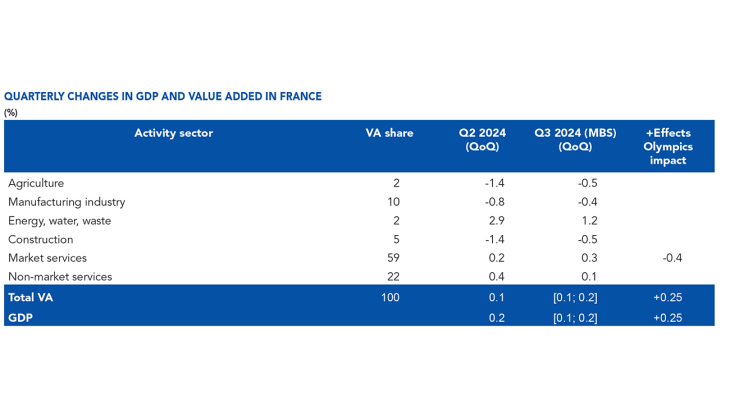
Note: QoQ = quarterly change.
Download the full publication
Updated on the 14th of October 2024